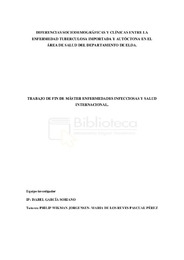Por favor, use este identificador para citar o enlazar este ítem:
https://hdl.handle.net/11000/35521Registro completo de metadatos
| Campo DC | Valor | Lengua/Idioma |
|---|---|---|
| dc.contributor.advisor | Wikman Jorgensen, Philip | - |
| dc.contributor.advisor | Pascual Pérez, María de los Ángeles | - |
| dc.contributor.author | García Soriano, Isabel | - |
| dc.contributor.other | Departamentos de la UMH::Medicina Clínica | es_ES |
| dc.date.accessioned | 2025-02-03T15:14:41Z | - |
| dc.date.available | 2025-02-03T15:14:41Z | - |
| dc.date.created | 2024-07-04 | - |
| dc.identifier.uri | https://hdl.handle.net/11000/35521 | - |
| dc.description.abstract | La tuberculosis es una enfermedad que afecta a más de 10 millones de personas a nivel mundial con una mortalidad de más de 1 millón. La epidemiología varía en función de la localización geográfica, porque está asociada a niveles socioeconómicos más bajos. En los últimos años ha aumentado la migración y por consiguiente la trasmisión de esta enfermedad. De esta forma analizamos las diferencias clínicas y epidemiológicas entre personas con enfermedad tuberculosa autóctona y migrantes. Métodos: Estudio observacional analítico de cohortes retrospectivo de pacientes con enfermedad tuberculosa importada y autóctona diagnosticada en el Departamento de Salud de Elda en el periodo entre 2013 - 2023.Resultados: Se diagnosticaron 98 pacientes con tuberculosis 29.6% eran migrantes. Un 67,3% del total fueron hombres, 65% migrantes varones y 34.5% migrantes mujeres. La media de edad de los migrantes era de 35.6 años (21.3-50) y la de los nacionales 48.03 (30.37-35.7) (p < 0,001). La tuberculosis pulmonar fue del 82% en ambos grupos. Un 66% de los no migrantes y 34% migrantes (p 0.007) fueron fumadores y consumían alcohol el 46% en población española y 10.3% migrantes (p 0.01). Encontramos 9 casos de resistencias al tratamiento tuberculosos 20.7% en la población migrante y 17.24% correspondían con resistencia a isoniazida y 3.44% a multirresistente. Tanto en la curación, como en la mortalidad y en el ingreso no se encontraron diferencias significativas en ambos grupos. Al analizar la variable desenlace, encontramos diferencias entre sexos y con niveles altos de PCR p= 0.033. Conclusión: La enfermedad tuberculosa en población migrantes representó el 29% del total de los casos. Existe mayor prevalencia en hombres en ambos grupos, pero en el caso de los migrantes con una edad más joven. Los migrantes presentan menos consumo de tóxicos que los nacionales. No se encontraron diferencias en la curación, el ingreso y la mortalidad entre ambos grupos, viendo que el desenlace desfavorable está relacionado con el sexo masculino y con determinantes como el nivel de PCR. | es_ES |
| dc.description.abstract | Tuberculosis is a disease that affects more than 10 million people worldwide with a mortality of more than 1 million. The epidemiology of this disease varies depending on the geographical location, because it is associated with lower socioeconomic levels. In recent years, migration has increased and therefore the transmission of this disease. In this way, we analyze the clinical and epidemiological differences between people with native and migrant tuberculosis disease.Methods: An analytical observational study of retrospective cohort study of patients with imported and native tuberculosis disease diagnosed in the Elda Department of Health between 2013 - 2023.Results: 98 patients with tuberculosis were diagnosed from, 29.6% of them were migrants. Of the total, 67.3% were men, of whom 65% were male migrants and 34.5% female migrants. The average age of migrants was 35.6 years (21.3-50) and the average age of national patients was 48.03 (30.37-35.7) (P <0,001). Pulmonary tuberculosis was 82% in both groups. 66% of non-migrants and 34% of migrants (p 0.007) were smokers and 46% of the native population and 10.3% of migrants (p 0.01) consumed alcohol. We found 9 cases of resistance to tuberculosis treatment 20.7% in the migrant population of which 17.24% corresponded to resistance to isoniazid and 3.44% to multiresistant strains. No significant differences were found in both groups in terms of cure, mortality and hospital admission. When analyzing the unfavorable evolution variable, we found differences between sexes and high levels of PCR.Conclusion: Tuberculosis in the migrant population was reported 29% of all cases. There is a higher prevalence in men in both groups, but in the case of migrants were younger men. Migrants have less toxic consumption than native ones. No differences were found in cure, hospital admission and mortality between both groups, seeing that the unfavorable evolution variable is related to the male sex and with determinants such as the level of PCR. | es_ES |
| dc.format | application/pdf | es_ES |
| dc.format.extent | 28 | es_ES |
| dc.language.iso | eng | es_ES |
| dc.publisher | Universidad Miguel Hernández | es_ES |
| dc.rights | info:eu-repo/semantics/openAccess | es_ES |
| dc.rights | Attribution-NonCommercial-NoDerivatives 4.0 Internacional | * |
| dc.rights.uri | http://creativecommons.org/licenses/by-nc-nd/4.0/ | * |
| dc.subject | tuberculosis migrante | es_ES |
| dc.subject | resistencias alcohol tabaco | es_ES |
| dc.subject | mortalidad | es_ES |
| dc.title | Diferencias sociodemográficas y clínicas entre la enfermedad tuberculosa importada y autóctona en el área de salud del departamento de Elda | es_ES |
| dc.type | info:eu-repo/semantics/masterThesis | es_ES |

Ver/Abrir:
Isabel García Soriano.pdf
292,2 kB
Adobe PDF
Compartir:
 La licencia se describe como: Atribución-NonComercial-NoDerivada 4.0 Internacional.
La licencia se describe como: Atribución-NonComercial-NoDerivada 4.0 Internacional.
.png)